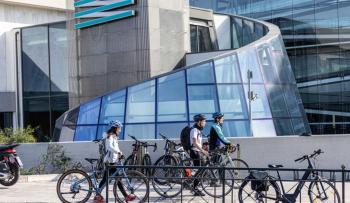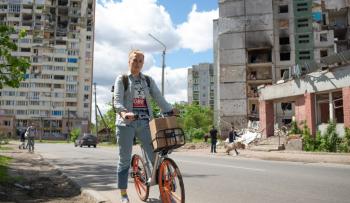
Arup: “We believe that inclusive connectivity and mobility are essential for cities to thrive”
Facing climate change impacts and rapid urbanisation, cities and regions are under pressure to adapt swiftly. Committed to sustainable development and drawing from broad expertise in active travel, Arup helps develop walking and cycling strategies aimed at building more inclusive and resilient cities and communities. ECF is therefore delighted to announce Arup as the sponsor for the Cities & Regions for Cyclists Network Day for the second year in a row. We spoke to Léan Doody, Cities, Planning and Design Leader for Europe at Arup, about Arup's vision for the future, holistic approach to urban mobility and the importance of networks like Cities & Regions for Cyclists in facilitating city-to-city knowledge transfer.
What makes Arup’s approach to the built and natural environment unique?
The impacts of climate change are being felt around the world. Cities and organisations are redefining how they plan, invest and operate for a more resilient future. Changing international regulation is reframing the investment landscape while vital national commitments like net zero require detailed foresight and planning.
Arup helps actors across the public and private sector to evaluate climate and sustainability issues. We produce plans to prepare cities and organisations to become truly net zero. Our advice spans economic planning, environmental, energy and sustainability expertise, business strategy and regulatory compliance.
What’s your vision for the future of cities and what role does cycling play in that?
With nearly 70% of the world’s population set to live in cities by 2030, including rapid urbanisation in the developing world, cities are at the forefront of the issues caused by climate change. We believe that inclusive connectivity and mobility are essential for cities to thrive, supporting residents’ access to healthcare, education and jobs.
Cycling has the potential to tackle issues such as CO2 emissions and congestion and also has an often-underrated positive impact on societal health and wellbeing.
We take a holistic approach to urban mobility, connecting active travel with other forms of public transport to ensure that everyone feels safe and confident embracing cycling and active travel modes as a regular part of their commute plans.
What opportunities does the CRC (Cities and Regions for Cyclists) Network present to Arup and the realisation of its wider goals?
The CRC Network facilitates city-to-city knowledge exchange – aligning perfectly with Arup’s ethos of collaboration.
From climate change to city resilience, we work with a large number of partnerships across the globe. We believe these long-term collaborations can help us tackle some of the world’s toughest problems.
When it comes to embracing the uptake of cycling in cities everywhere, we are delighted to have this platform where we can learn from and share our insights with cities in their drive towards sustainable and more inclusive transport.
How do you draw on your expertise to help cities and regions become more cycle friendly?
Arup has nearly 80 years of experience providing sustainable design and advice on the many ecosystems that make up our cities, engaging communities to create more resilient buildings and infrastructure. We adopt a holistic approach to consider the purpose and legacy of these elements, so we can provide meaningful advice to cities on sustainable urban design and development, including cycle infrastructure and cycle culture.

What is an example of an impactful cycling strategy that you have co-designed with a city?
In Türkiye, we have worked with Ankara Municipality to develop an integrated cycle strategy and masterplan that connects with public transport modes. Funded by the UK’s FCDO (Foreign, Commonwealth & Development Office), the plan aims to develop a bike-friendly culture by delivering quality cycling infrastructure, awareness measures, governance and capacity-building.
Social acceptance and a widespread modal switch towards cycling are key. Our communications and change management consultants worked closely with the municipality to advise on promoting cycling and garnering public support.
We surveyed approximately 10,000 residents on their transport habits and held focus groups with representatives from Ankara’s district municipalities, academics, non-governmental organisations and cycling groups.
Our transport planners used a Geographic Information System (GIS) to create web maps of the proposed cycle routes, providing analysis at a city scale as well as more detailed representations of neighbourhood cycle paths, kickstarting dialogue in the workshops. The project included the design of a 6km+ pilot, which has been implemented, as well as designing bespoke cycle parking.
In what ways do you take a data driven approach to the development of cycling strategies?
Our work on urban cycling always begins with data analytics to develop a thorough understanding of movement patterns in cities, its trends and constraints. By adopting an integrated, multimodal analysis lens – and harnessing the insights of the local community – we can map and predict these patterns, including potential future demand.
For instance, in The Hague, we worked with the municipality to predict traffic flows to the beach during warm days. By analysing traffic, light and weather data, we were able to predict busy moments, enabling the city to prioritise bike traffic to ease congestion.
How do you ensure that your design and planning processes for cycling strategies include a diversity of stakeholders?
Local stakeholders, be it local authorities or community groups, have a wealth of information and contextual knowledge which is essential to bring into the process.
Consultation strategies vary from project to project, depending on context, regulatory frameworks, project scope and objectives. In all cases, Arup engages closely with local stakeholders and the community – including hard to reach groups – to ensure project outcomes can deliver transformative change. For instance, our report for Transport Infrastructure Ireland highlighted how transport systems are far from being gender-neutral and offered a new perspective to discussions about equal access to public infrastructure.
Part of our approach to encouraging the adoption of cycling and active travel is to analyse and model current use, engage and consult local community and stakeholders so we can co-design and plan interventions that enhance safety and accessibility for all (beyond only early adopters), making sure it reaches everyone in the community.
Why do you think community engagement is important during the design process of cycling strategies? And how do you facilitate this?
Urban design strategies have to consider the needs of the community to create the desired impact. A transformative cycle strategy, such as our work in Ankara, involves more than delivering infrastructure. Buy-in from the community helps to ensure that a cycle culture can flourish alongside the delivery of infrastructure.
Cities that are keen to embrace cycling as a viable, sustainable travel mode will require a combination of top-down and bottom-up approaches, blending together policy, provision of infrastructure, community engagement and awareness building.
Photo Credits: Arup
About Cities & Regions for Cyclists: Cities & Regions for Cyclists is a network bringing together local and regional administrations, actively working to promote the bicycle as a mode of transport and leisure. For more information on the network and how to join, click here.
Network/Project Involved:
Contact the author
Recent news!
Upcoming events
Contact Us
Avenue des Arts, 7-8
Postal address: Rue de la Charité, 22
1210 Brussels, Belgium









